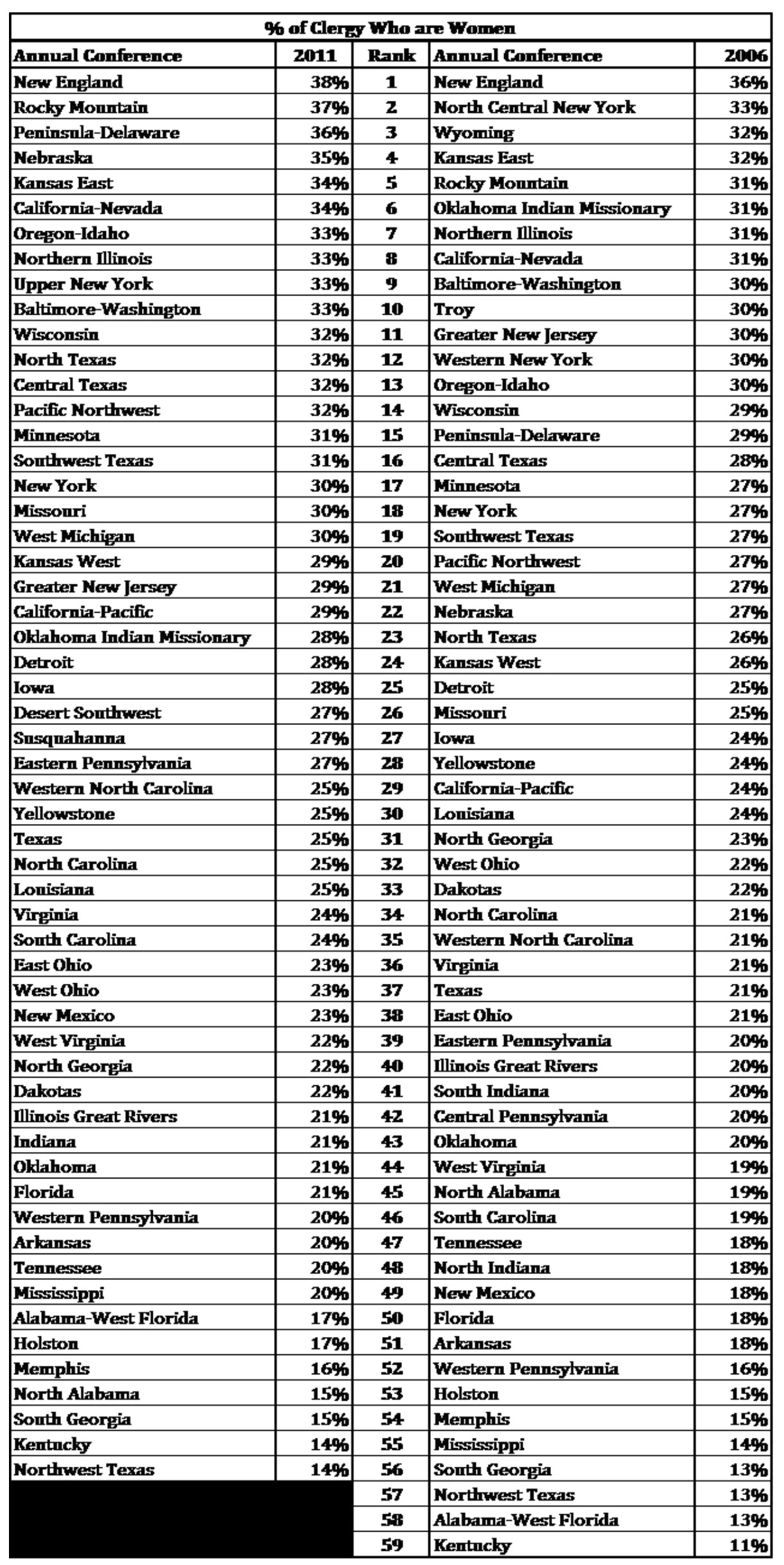By Erin Kane Director of Research and Monitoring
GCSRW is happy to report that in 2011, the year of the most recent available data (from the General Council on Finance and Administration), The United Methodist Church in the United States has experienced a 13% growth in the number of women clergy, to 11,368 from 10,128 in 2006. The growth comes despite a net decline in overall clergy (men and women) of 53 people in the same time frame, a 0.1 percent decline.
A third -- or more
The table to the right illustrates the profound gains of women clergy in the UMC. (The full table is available at the end of the article)
- In 2006, 22% of annual conferences (13 out of 59[1]) could boast that women comprised 30% or more of clergy positions, only 2 of which could report at 33% or more.
- In 2011, 34% of annual conferences (19 out of 56) reported that women comprised 30% or more of clergy positions, 10 of which can brag of 33% or more.

What affected the numbers?
-
Decline in local clergy membership
In 2006, GCFA reported a total of 44,979 clergy, and in 2011 it reported 44,926 clergy. The decline of clergy in the church nationwide was negligible for a five-year period (~4650 lost overall and ~4600 added). However, some annual conferences experienced a concentrated portion of this shift. For example, Nebraska’s clergy membership was reduced by 46%, with a net loss of 220 people, only 38 of whom were women, thereby increasing the membership of clergywomen by 30%, bringing them into the top ranks. The clergy membership of the Oklahoma Indian Missionary Conference fell by 24%, a net loss of 17 people, where women were lost at a rate of 32% and men at a rate of 22%, which caused it to fall below the 30% floor.
-
Merged conferences
From 2006 to 2011, several annual conferences split and/or merged with other nearby conferences. For example, in 2010, the front runner New England conference gained a part of the Troy conference, which contributed to its top rank in 2011. Meanwhile, the Wyoming and North Central New York (who had the second and third highest percentages in 2006 respectively) contributed numbers to the newly formed Upper New York annual conference, placing it within the 33% or more range
Paragraph 142 of the 2012 Book of Discipline defines clergy as ‘individuals who serve as commissioned ministers, deacons, elders, and local pastors under appointment of a bishop (full- and part-time), who hold membership in an annual conference, and who are commissioned, ordained, or licensed.”

GCSRW would also like to highlight the five annual conferences that have most increased their clergywomen percentages from 2006 to 2011[2]
- Mississippi had a net gain of 67 women in their clergy membership, a 44% increase.
- Alabama-West Florida had a net gain of 36 clergywomen, a 39% increase.
- Eastern Pennsylvania had a net gain of 53 clergywomen, a 35% increase.
- Kentucky had a net gain of 31 clergywomen, a 34% increase.
- Peninsula-Delaware had a net gain of 36 clergywomen, a 30% increase.
The Big Picture
Women now make up 25% of the total U.S. clergy population due to the 13% increase, a net gain of 1,240 women. This is a significant advancement from the 11% clergywomen population in 1992 and 19% in 2002.

[1] The numbers reported by the General Council on Finance and Administration for 2011 and 2006 were gathered from annual conferences who self-reported their data, during these years some conferences split and merged with other conferences, changing the total number of conferences calculated in this set to 56 from 59. Some conferences were not included in the calculations at all due to a lack of submitted data. As a result, overall totals may be inaccurate. For this reason, some conferences are not included in the lists that may have been otherwise. Conferences not included in the data set are: Alaska Missionary, Red Bird Missionary, and Rio Grande. [2] Nebraska was excluded from this list because of the default gain from the large loss of clergy membership.

